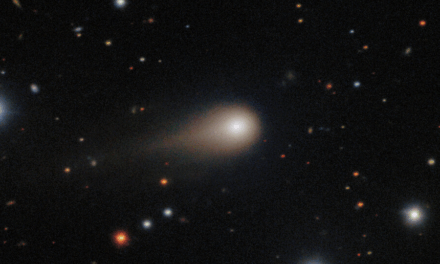A galaxy is a gravitational bound system that consists of stars and stellar remnants, an interstellar medium of gas and dust, and an important but poorly understood components called dark matter. A galaxy typically contains to
stars, orbiting around the center of gravity of the galaxy. There are different physical structures of the galaxies and are broadly categorized into three that is elliptical, spiral and irregular galaxies. Known properties of these three different structures are given below:
| Galaxy type | Mass |
Luminosity |
Diameter (kpc) | Stellar populations | Relative abundances |
|---|---|---|---|---|---|
| Spiral & barred spiral | |
|
5 – 250 | Halo: population II disk population I | 77% |
| Elliptical | |
|
1 – 205 | Population II | 20% |
| Irregular | |
|
1 – 10 | Population I | 3% |
Here is mass of the sun and
is the Luminosity of the sun.
The density of matter may be very different in different galaxies and in different part of the same galaxy. Thus, evolution of a galaxy will be the result of a processes occurring on vastly different time and energy scales. No generally accepted comprehensive theory of evolution exists as yet.
It is estimated that there could be galaxies in the observable universe. The space between galaxy is known as intergalactic space, is usually filled with tenuous plasma having an average density of less than 1 atom per cubic meter.
Spiral galaxies (disk galaxies) are supported by rotation whereas elliptical are supported by random velocity dispersion.
The most massive galaxies in the sky are giant elliptical galaxies. The main driving force for the evolution of elliptical galaxies is mergers of smaller galaxies. The mergers can be extremely violent, galaxies often collide at speed of 500 km/s.
During the merger, a typical galaxy can make thousands of solar masses of new stars each year, which is large compared to our galaxy which makes around 10 new stars each year.
The majority of giant galaxies contain super massive black hole in their centers ranging in mass from millions to billions of times the mass of our sun.
The majority of mass in galaxies is made up of dark matter, a substance that interacts by means of gravity. These substance do not interact via electromagnetic radiation.
ΛCDM or Lambda-CDM model
The simplest model for galaxy or structure formation that is in general agreement with observation is the Λ Cold Dark Matter (ΛCDM) cosmology. This is also known as ‘cold dark matter model with dark energy.’ It attempts to explain the existence and structure of the cosmic microwave background, the large scale structure of galaxy clusters, distribution of hydrogen, oxygen, lithium and helium and the accelerating expansion of the universe.
In the term ΛCDM ‘Λ’ stands for the cosmological constant which is currently associated with a vacuum energy or dark energy in empty space that explains the current accelerating expansion of space against the attractive effects of gravity. Currently, about 73% of the energy density of the present universe is estimated to be dark energy.
Cold dark matter is a form of matter necessary to account for gravitational effects observed in very large structures that can not be accounted for by the quantity of observed matter. Dark matter is described as being cold (its velocity is non-relativistic), possibly non-baryonic, dissipation less (cannot cooled by radiating photon) and collision less. This component is currently estimated to constitute about 23% of the mass energy density of the Universe. The remaining 5% comprises all matter and energy observed as subatomic particles, chemical elements and electromagnetic radiation (i.e. visible planets, stars, galaxies etc).





